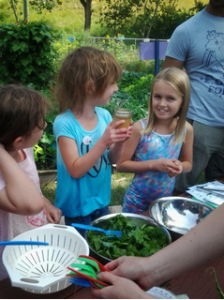1. Maintain a balanced diet of fruit and vegetables, whole grains and lean meats. Ensure that vegetables fill half of your plate, with one quarter whole grains and the remaining quarter with lean meat.
2. Reduce your fat intake by cutting off visible fats and removing the skin from poultry, use fat-free cooking methods like steaming, poaching, use of non-stick pans or spray oil to reduce the amount of fat (saturated and trans fat) in your diet.

With the start of the New Year comes the perfect opportunity to renew your commitment to healthy eating, and while you’re at it, why not teach your kids how to eat healthy too? Poppy Innovations created the Parent & Child Culinary Program, to do just that. The hands-on program teaches kids nine and older how to chop vegetables, cook meat, choose healthy ingredients and so much more!
“Kids are a lot more capable in the kitchen than we think. In our program we teach children how to use kitchen knives, cook on the stove and with the oven, and use a variety of kitchen equipment,” says Sharon McCormick, CEO of Poppy Innovations.
The Parent & Child Culinary Program runs once a week for six weeks, and during each session the children learn and practice cooking a new meal made with local and healthy ingredients. Weaved into the cooking lesson is information about the four food groups, the importance of vegetables, and the benefits of buying locally sourced food.
Karyn Sunohara, is one of the dietitians who leads the program, “We talk about creating balanced meals, filling half the plate with vegetables, one-quarter with protein and the last quarter with a starch. We also discuss how locally grown food has more nutrients, and that treats are ok, as long as we limit them,” she says.
Gillian Gray attended the program with her two children last year. “I thought it’d be a nice chance to spend some quality time with the kids while they learned some great nutritional lessons. They were really excited about the big kitchen,” she recalls.
“They learned to prepare vegetables and meat, use lots of different kitchen gadgets, and work with a chef’s knife,” remembers Gillian, “My comfort level around them using the knives greatly improved.”
Even a year later, Gillian’s children still use the skills they learned in the program, “After school they will prepare themselves a healthy snack rather than grab something quick from the pantry and my son will cook his own eggs for breakfast instead of eating cereal,” says Gillian.
The winter sessions of the Parent & Child Culinary program start on January 20 at the South Health Campus and on January 21 at Calgary CO-OP Crowfoot location. Both sessions run from 5:30pm-7pm once a week for six weeks. Visit our website to register and check out the many programs we have to offer.


]]>

It’s hard to believe in just a few days Halloween will be here! The days after Halloween tend to be dreaded days for parents and teachers who are seen as the food police! Many homes turn into temporary candy lands. Did you know the average child arrives home from trick or treating with a pillow case of candy weighing approximately 5 lbs! That’s equates to 8 cups of sugar, 400 teaspoons, or 40 cans of pop and over 10,000 calories.
Tips for your ghosts and goblins:
1. Avoid purchasing halloween candy until a couple days before. Most of us are guilty of buying candy early and then having a sweet tooth craving and diving into the treats early and having to re-buy more candy for Halloween. Buying it closer halloween helps to breaks that temptation.
2. Don’t stock up on Halloween treats you love and you’ll be less tempted to eat it.
3. Any leftover treats near the end of the night start giving trick or treaters more so there are no leftovers.
4. Make sure your children have a full nutritious meal before heading out trick or treating.
5. Limit the number of pieces of candy you and/or your children have each day. Avoid depriving you or your children from having a couple treats this will prevent sneaking of food or breaking your allotted candy for the day.
6. When your children come home from trick or treating let your children make a pile of likes and dislikes donate the pile of dislikes to local food banks or community centres.
7. After a couple weeks if the candy is still around, throw it out.
8. Check out our Poppy Innovations’ Facebook page for ideas for healthy halloween treats!
]]>
Back to School: Packed Lunch Tips
1) Variety – Kids get tired of having the same thing. Change it up! Let them come to the grocery store with you and help pick out healthy options.
2) Get the kids involved – Get the kids involved in helping prepare their lunches. Studies have shown children are more likely to eat the food if they have contributed to it.
3) Schedule time – Set aside time for making lunches, maybe after dinner to beat the morning mayhem.
4) Use Canada’s Food Guide – keep Canada’s Food Guide close to use it as a teaching guide to ensure you get all the food groups.
5) Be a role model – pack your lunch along side the kids
Check out these sites for more ideas:
Dietitians of Canada – Brown Bag Lunches
http://www.dietitans.ca/Nutrition-Resources-A-Z/Factsheets/Lunches/Brown-Bag-Lunches.aspx
What not to pack
http://www.healthandlifestyle.ca/health/healthy-eating/what-not-to-pack-in-your-childs-lunch-for-back-to-school/
How to ward off the after-school sugar rush
http://www.theglobeandmail.com/life/health-and-fitness/health/how-to-ward-off-the-after-school-sugar-rush/article20293820/
Do you need some cooking tips on how to get your kids involved in the kitchen? We’ve partnered with Alberta Health Services to offer a selection of Parent and Child Culinary classes starting this fall at two locations check out our schedule.
]]>

Follow us on Pinterest for new recipe ideas, gardening tips and more!
]]>Congratulations to the winning Healthy Selfie photo from Heather Heystek – her daughter eating her favourite morning snack – cherries!
Thank you so much for entering Poppy Innovations’ Healthy Selfie photo contest. We appreciate your entry and showing our community how you’ve integrated healthy choices over the summer. With your help, we’re building a healthier community by changing the way we eat and look at food.
Check out our website for upcoming contests: https://www.poppyinnovations.ca/contests/
]]>
Michael Pollan’s 2006 book, “The Omnivore’s Dilemma,” detailed the complex system of farms, feedlots, and food science laboratories that deliver food to the modern dinner table, and helped fuel a growing food movement. His newest work, “Cooked: A Natural History of Transformation,” recently published in paperback, turns his attention to how plants and animals are transformed into meals and explores why cooking is important.
After “Omnivore,” Pollan focused on the human end of the food chain, looking at food choices and their impact on health. “I realized cooking was the answer to a lot of questions that I’ve been exploring in my work,” Pollan, 59, says. For “Cooked,” he apprenticed with a series of culinary experts — from a North Carolina barbecue pit master to a celebrated baker — to understand the ecological, nutritional, and cultural impacts of cooking from scratch.
“I got into this as someone who was very interested in the environment and how we engage with the natural world,” Pollan says. “I like to cook and I knew how to grill, make pasta, pretty basic stuff. But there was a lot for me to learn.”
Q. How did it happen that you turned your attention from agriculture to cooking?
A. I began to realize that if people insist on having their food cooked by fast food corporations or processed food corporations, we weren’t going to build this alternative agriculture system.
Q. Why is cooking important to one’s health?
A. The best marker of a healthy diet was whether the food was cooked by a human being. Even poor people who still cook have healthier diets than rich people who don’t.
Q. Explain how cooking and health are so closely linked.
A. If you cook, you’re not going to have french fries every day. Homemade french fries are delicious, but they’re such a pain to make. There are things built into the process of cooking that guard against those very tempting, but ultimately not very healthy, foods. You don’t even have to worry about what you’re cooking because you will naturally gravitate toward simple things. You will not make a lot of junk food.
Q. You also talk about the social benefits of cooking and eating together.
A. Cooking isn’t just about preparing the fuel for your body. Cooking is a social act and it has been since we started. Go back 2 million years, and we discover the power of fire to change food and make it more delicious, easier to digest, safer. But as soon as we do that, we have to learn how to share. Cooking gave us the meal and the meal gave us civilization. And that’s what we’re now blithely giving up. Forty-six percent of meals in America are now eaten alone. We have this centrifugal force that’s driving us away from the table. And a lot of that goes to food marketing. They make more money if we eat individually.
Q. Whileyou were writing the book, your son suggested taking a night off from cooking to have “microwave night.” How did that work out?
A. What a surprise. To get four entrees on the table took 45 minutes, which is plenty of time to cook a very nice meal. We just never got to sit down at the table at the same time because we were each in a different stage of defrosting and eating. It was the most disjointed family meal we had in a long time and no time had been saved. We have to reexamine this assumption that convenience food is really convenient.
Q. What do you say to the argument that cooking is also expensive?
A. I dispute that. You have to pay those people to process food. It’s very labor intensive on their end, so therefore they charge. Cooking is economical. There’s still a lot of healthy food in regular markets as long as you shop the periphery and avoid the processed foods. It is more time-consuming. We have dropped the amount of time we spend on cooking by about a half an hour since 1965. I think it’s important to look at what you’re doing with that half-hour and whether it’s more valuable to you.
Q. Clearly you see that cooking is time well spent.
A. My contention is that as a way to spend a half-hour or an hour of your leisure time, cooking is a really good way to do it. It has all these benefits, but it’s actually intellectually very engaging. It’s sensually very pleasurable. It’s a great way to reset. But the key is not doing it alone, I think. Get your family involved. Get your kids and your partner in the kitchen. Make it a social event.
Interview was condensed and edited. Michael Floreak can be reached at [email protected].
]]>



